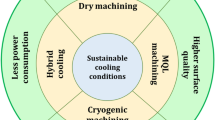Abstract
The titanium alloy has a low thermal conductivity of 1/8th that of common metals and half that of stainless steel. The heat dissipation is poor during dry cutting, so the cutting temperature rises above about 600°C. Due to this, the quality of the cutting surface decreases during machining, and rapid tool wear occurs. To solve this, the use of cutting fluid is essential, but the chemical composition of the cutting fluid has a negative effect on the body and the environment. In the current cutting process, in order to minimize this effect, eco-friendly processing using minimum quantity lubrication (MQL) is performed. The machining method using both MQL and a cryogenic gas separately applies the MQL and the cryogenic gas to both sides of the cutting tool. In this case, the oil mist cannot penetrate the cutting zone due to the spray pressure of the cryogenic gas. Therefore, it is necessary to design a hybrid nozzle that can spray oil mist and cryogenic gas into a single flow. Besides, although the study on the effect of MQL and cryogenic machining on the cutting temperature should be preceded, most of the titanium MQL processing papers only study the material surface and tool wear. Accordingly, in this study, we designed and fabricated the hybrid type nozzle of CryoMQL which combined MQL and a cryogenic gas to improve the spraying concentration. And the cutting temperature generated by the process was measured, and the effectiveness of the proposed nozzle on decreasing the cutting temperature was evaluated. Besides, cutting force and tool wear were analyzed according to each cutting method.














Similar content being viewed by others
References
Vedrtnam A, Chaturvedi SK (2019) . Invertis J Sci Technol 12(4):153
Mia M, Khan MA, Dhar NR (2017) . Int J Adv Manuf Technol 90(5–8):1825
Liang X, Liu Z (2018) . Tribol Int 121:321
Guo S, Li C, Zhang Y, Wang Y, Li B, Yang M, Zhang X, Liu G (2017) . J Clean Prod 140:1060
Javaroni R, Lopes J, Sato B, Sanchez L, Mello H, Aguiar P, Bianchi E (2019) . Int J Adv Manuf Technol 103(5–8):2809
Meza F, Chen L, Hudson N (2013) . Am J Ind Med 56(12):1394
Shokrani A, Dhokia V, Newman ST (2012) . Int J Mach Tools Manuf 57:83
Pereira O, Rodríguez A, Barreiro J, Fernández-Abia AI, de Lacalle LNL (2017) . International Journal of Precision Engineering and Manufacturing-Green Technology 4(1):87
Pereira O, Rodríguez A, Fernández-Abia A, Barreiro J, de Lacalle LL (2016) . J Clean Prod 139:440
Damir A, Shi B, Attia MH (2019) CIRP Annals
Shokrani A, Dhokia V, Newman ST (2017) . Procedia Manufacturing 11:625
Rahim E, Ibrahim M, Rahim A, Aziz S, Mohid Z (2015) . Procedia CIRP 26:351
Bradshaw P (1973) Effects of streamline curvature on turbulent flow. Tech. rep. Advisory Group For Aerospace Research and Development Paris (France)
Trancossi M, Maharshi S, Angeli D (2013) .
Chung JH (2019) Minimization of jet flow rate through hybrid type injection nozzle design and improvement of cutting characteristics of titanium alloy. Inha University
Zhu D, Zhang X, Ding H (2013) . Int J Mach Tools Manuf 64:60
Funding
This study was financially supported by the Ministry of Trade, Industry and Energy and the Korea Evaluation Institute of Industrial Technology (KEIT) in 2017 (“1077292”).
Author information
Authors and Affiliations
Corresponding author
Additional information
Publisher’s note
Springer Nature remains neutral with regard to jurisdictional claims in published maps and institutional affiliations.
Rights and permissions
About this article
Cite this article
Song, K.H., Lim, D.W., Park, J.Y. et al. Investigation on influence of hybrid nozzle of CryoMQL on tool wear, cutting force, and cutting temperature in milling of titanium alloys. Int J Adv Manuf Technol 110, 2093–2103 (2020). https://doi.org/10.1007/s00170-020-05646-7
Received:
Accepted:
Published:
Issue Date:
DOI: https://doi.org/10.1007/s00170-020-05646-7



